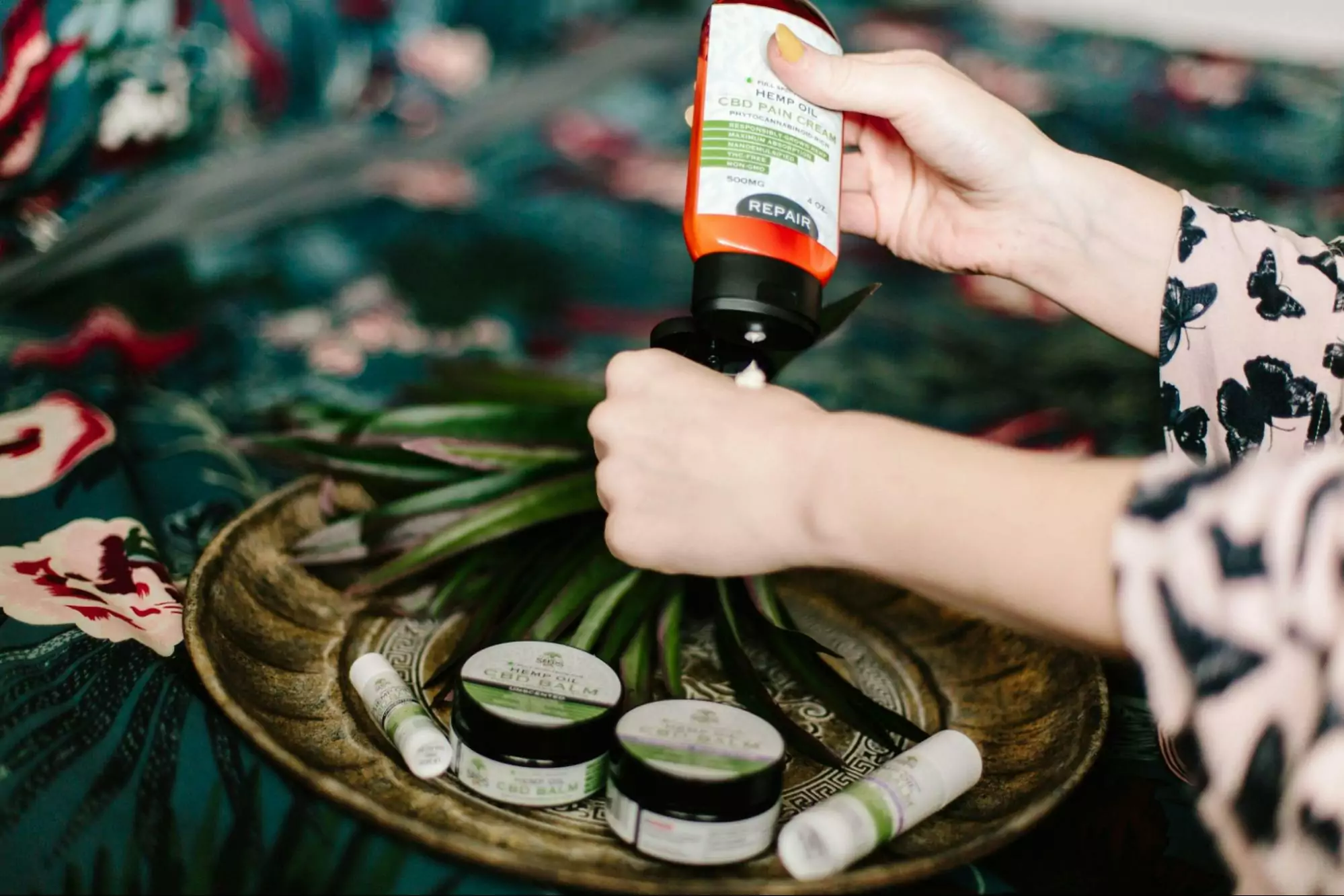Create Your Product
Before you dive into designing logos or picking a name, the first step is to identify a skincare range you know your customers will love.
Read on to learn how to start a skincare line:
1️⃣ Clearly define your product’s goal
The skincare industry is full of potential, but chances are you’re entering the skincare market for a specific reason.
Maybe you’ve seen a gap in the market, or you’re passionate about solving a particular skincare issue.
Either way, understanding your “why” is key to developing a product that stands out:
💡 If you’re a dermatologist, maybe you’ve noticed a recurring issue with your patients, like chronic dryness or acne scars, and you want to create a solution.
💡 As a beauty influencer, perhaps your followers keep asking for help with sensitive skin or recommendations for eco-friendly products, and you see a business opportunity.
💡 If you’ve struggled to find products that work for your own skin, this may have inspired you to create something that helps others with similar issues.
Whatever your reason, this is where your product’s goal originates from.
Start by outlining the specific problem your product aims to solve. This will guide all the decisions you make going forward.
🎯 Success Story: How Faace set its goal
Jasmine Wicks-Stephens, founder of Faace, created her own skincare line after becoming a mother and finding no time for complex skincare routines.
Her goal? To make products that are easy to understand and use.
Faace products are named after skin concerns like “dull” or “sweaty” to make it easy for customers to know exactly what they need.
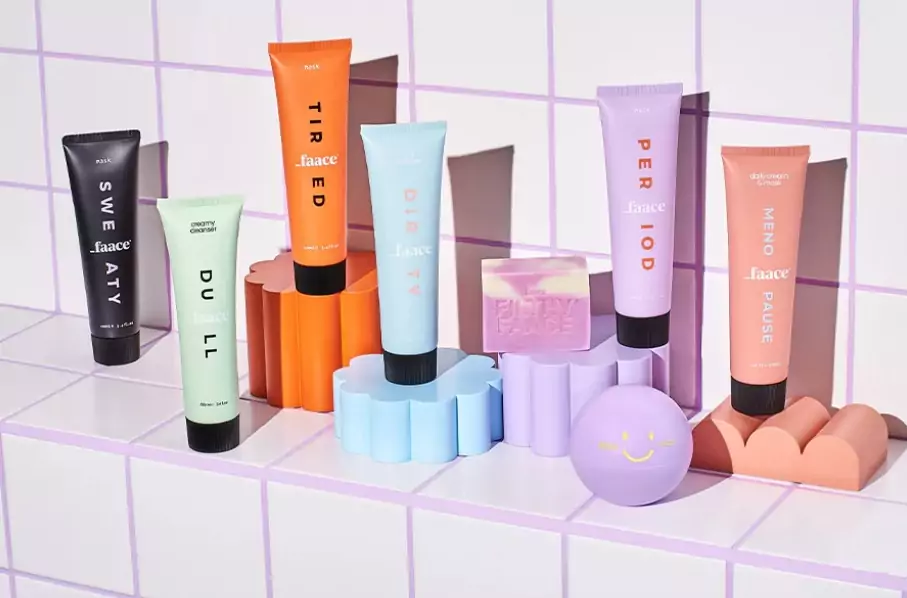
“When I launched the brand, I was looking at it with my consumer hat on, rather than my business owner hat,” she shared in an interview with The Sun.
“It’s really important that you give your product a clear goal and make sure it’s going to stand out.”
2️⃣ Conduct market research
Once you know what you want to achieve, it’s time to make sure there’s a market for it.
If you create a sophisticated skincare line for older adults, but in reality they tend to prefer simple and affordable products, your business might fail to hit the mark.
According to Numerator, there are two main skincare trends you should keep an eye on:
📈 Consumers are getting savvier. In the past, customers may have overlooked questionable ingredients, but now they’re much more informed. They know what’s in their products, and if yours lacks transparency or clear benefits, they’ll move on quickly.
📉 Affordability matters. More consumers are looking for affordable products that still deliver premium results. If you plan to position your brand as high-end, you’ll need to ensure it offers real value compared to the competition.
Get online and find out exactly what people are looking for in skincare. A great way to start is by using Google Trends to track the popularity of certain skincare buzzwords.
Simply type in a term like “retinol” or “hydrating serums,” and Google Trends will show you whether interest in that term is rising or falling, and you can even compare the popularity of these terms over time:
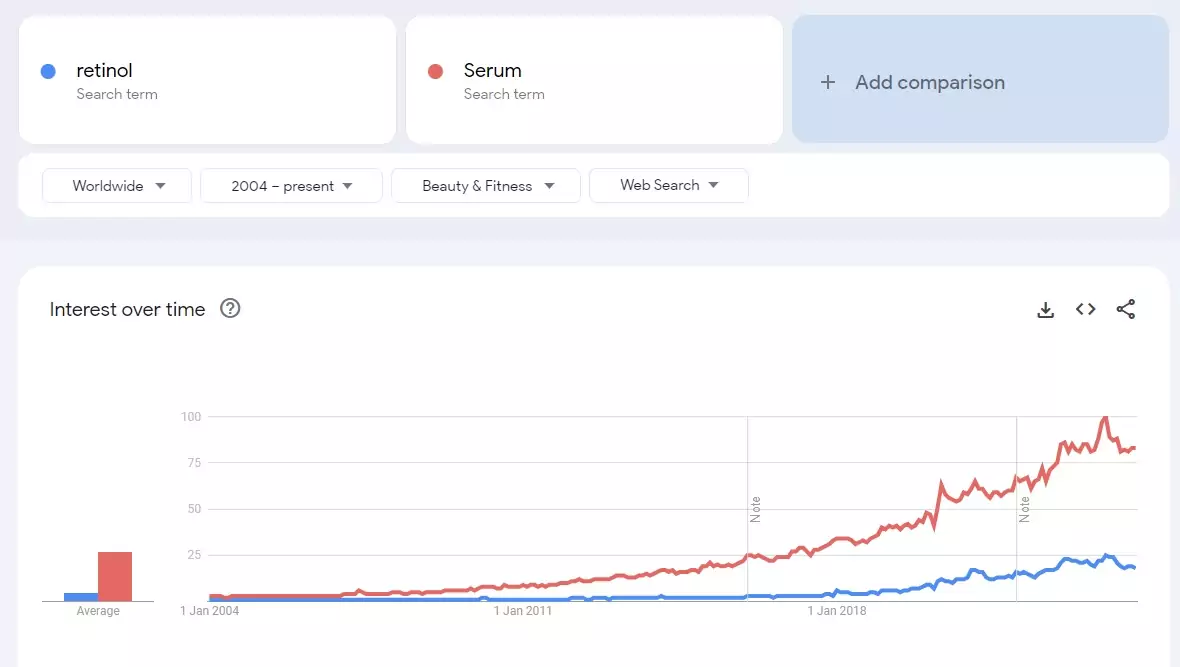
This helps you spot current and emerging trends and determine whether your idea aligns with what people are currently searching for.
💌 How to leverage your followers
If you have a significant online following, take advantage of that.
Set up polls on your social media platforms or run a survey to see whether your audience would be interested in your product idea.
Ask them specific questions about their skincare concerns, favorite ingredients, or what they feel is missing from the current market.
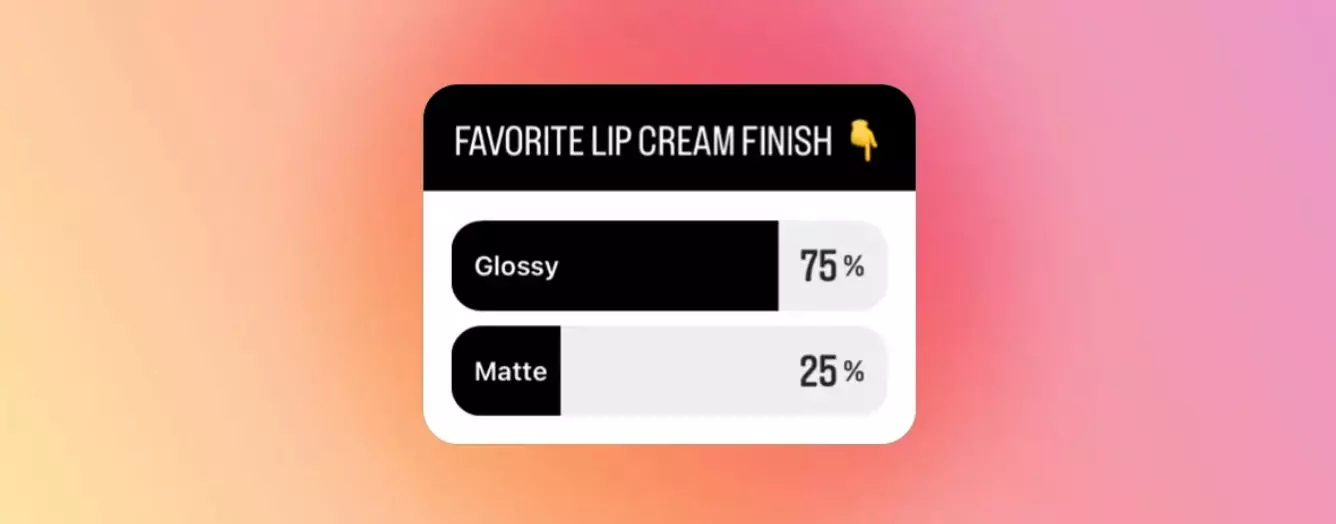
3️⃣ Choose your ingredients
Once you’ve confirmed interest in your skincare concept, the next step is selecting the ingredients that will help your product achieve its goal.
For example, if you’re creating a skincare line for young men to care for their skin after shaving, you might include Chamomile and Vitamin E.
When selecting your ingredients, it’s important to consider the cost. The more expensive the ingredients, the higher your product prices will be, which may limit access to your target market.
In 2024, some ingredients like lavender, glycerin, and citric acid have seen price spikes, driving up the cost of products that contain them.
To keep your line affordable, it’s a good idea to choose ingredients with a stable or lower cost that won’t fluctuate that much.
Adding unique ingredients can be a major selling point for your brand. Here are a few notable ones:
🧪 Epigenetics: Ingredients like niacinamide work on a genetic level to help your skin look healthier. This advanced science is often used in antiaging products.
🧪 Retinoids: A well-known ingredient derived from vitamin A, retinoids are excellent for reducing wrinkles, fine lines, and acne.
🧪 Tiger grass: Officially known as Centella Asiatica. this healing herb is known for its ability to repair the skin barrier and reduce redness.
When formulating your products, make sure to work with an experienced chemist or formulator to ensure that your ingredient choices are effective, safe, and meet industry requirements.
4️⃣ Create and test your skincare line
Before launching your skincare line, it’s essential to ensure your products are both safe and effective. While some testing can be done at home, lab tests are necessary for full validation.
Start by thoroughly researching your ingredients and consulting a toxicologist to confirm they’re safe for skin use.
You can also run some simple tests yourself, like the “challenge test,” where dip slides are used to check for microbial growth.
Doing these tests before heading to the lab can save you money. For instance, this test can cost between $500 and $2,000 at a lab, so it’s wise to avoid redoing them if possible.
Watch this video that shows how you can do at-home testing:
Once you’re confident with your initial checks, send your products to a lab for more thorough testing.
Labs will conduct stability tests, exposing your product to different environmental conditions—such as heat, humidity, and light—to evaluate its shelf life over time.
For products that contain water or spoil-prone ingredients, microbial challenge tests will ensure that your preservatives are effective.
Once your product has cleared these hurdles, it becomes necessary to test it on human volunteers to check for any allergic reactions or irritation.
Make sure you research and adhere to industry regulations in this regard; we highlight a few considerations below.
If you’re making specific claims, like antiaging benefits, you may need further trials to prove that it does what it claims.
5️⃣ Understand the regulations
Starting your own skincare line involves more than just crafting amazing products—it also means navigating regulations to ensure everything’s above board.
It might not be the most glamorous part of the process, but it’s important for your product’s long-term success and avoiding legal issues.
Here’s a quick rundown to keep things on track:
✅ Product registration: The FDA doesn’t pre-approve skincare products, but it does keep an eye out for banned ingredients. You don’t need formal approval, but registering your products in the FDA’s Voluntary Cosmetic Registration Program (VCRP) can help boost your brand’s credibility. Think of it as a helpful stamp of approval that shows you’re serious about quality.
✅ Safety assessment: Planning to sell in the UK or EU? Your products will need a Cosmetic Product Safety Report (CPSR) from a toxicologist to ensure they’re safe. Plus, you’ll need to register on the UK’s Cosmetic Products Notification Portal (CPNP) or its EU counterpart. It’s like getting a safety check before hitting the market, ensuring your products are up to standard.
✅ Labelling compliance: Your labels need to follow regional rules—this typically involves clear ingredient lists, truthful claims, and proper warnings. No matter where you sell, your claims (like “antiaging” or “hypoallergenic”) must be accurate and supported by evidence. It’s all about transparency and building trust with your customers.
✅ Good Manufacturing Practice (GMP): Adhere to GMP standards to ensure consistent quality. While GMP certification isn’t always a legal requirement, it’s a strong endorsement of your product’s reliability and safety. Think of it as a quality badge that reassures your customers.
Navigating these regulations might seem like a lot of red tape, but it’s vital for protecting both your customers and your brand’s reputation.
Whether you’re selling locally or aiming for international expansion, getting this right is crucial for success.
Plan Your Business
A great product is only part of the equation; solid business planning is equally important for success.
As you develop your skincare line, also consider aspects like funding, branding, and the business model that will best support your brand.
Here are some steps to get you started:
1. Find funding for your skincare brand
You may have used your own savings to cover the initial lab costs, but what about the ongoing expenses of setting up and running your own skincare brand?
Here are some solid options to consider for securing the funding you need:
💰 Bootstrapping: If you have some personal savings or a recent inheritance, you might choose to fund your skincare line yourself.
This is a great option because it means you won’t take on debt or have to share control of your business with others. It’s all about using your resources to keep things in your hands.
💰 Borrowing: Most entrepreneurs don’t have all the funds they need up front. In this case, a small business loan could be a good solution.
For example, 7(a) loans in the U.S. are designed to help startups get off the ground by offering them up to $5 million in funding.
However, like any other loan, you’ll need to meet your monthly repayments, which include interest costs.
💰 Crowdfunding: If traditional funding methods aren’t for you, consider launching a crowdfunding campaign.
Platforms like Kickstarter allow you to raise money by appealing directly to potential backers. You’ll need to offer benefits to your supporters, such as early access to your products.
For example, Beame is currently securing funding by offering their products to backers at a 30% discount:
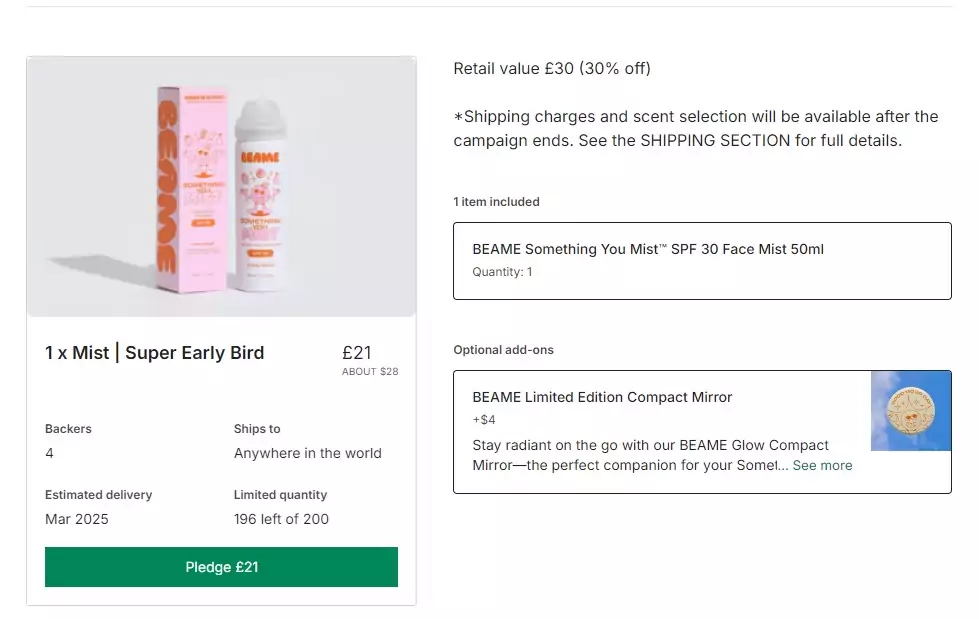
With financial backing in place, you’ll be well-positioned to cover production costs, market your products, and start making an impact in the global skincare market.
2. Set up your manufacturing
Many entrepreneurs in the beauty industry begin by crafting their skincare products in their kitchens.
This hands-on approach lets you personally interact with the ingredients and develop the formulas that align with your vision.
It’s a great way to stay connected with the heart of your brand identity—especially if you’re focused on creating natural or small-batch products.
However, as your business grows and demand increases, you’ll likely need to ramp up production.
This is where choosing a manufacturer comes in.
With some funding in your pocket, it’s time to decide whether you’ll produce your products locally or work with an international manufacturer.
These are the benefits of using a local manufacturer:
🏭 Closer collaboration: Being nearby allows you to visit the facility and see production in action, which helps with quality control.
🏭 Faster shipping times: Domestic production means you’ll avoid international shipping delays. It also removes the extra admin of coordinating international logistics to meet local demand.
On the other hand, an international manufacturer offers the following benefits:
🚢 Lower costs: Many beauty entrepreneurs turn to international manufacturers to reduce production costs, especially in countries known for lower-cost manufacturing, like China.
🚢 Access to specialized skills: Some regions are associated with expertise in beauty product manufacturing—for example, South Korea is known for its innovations in skincare.
In the end, your choice will depend on factors like cost, speed, and your brand’s focus.
💡 Just want to run a beauty business?
If you find that you’re more focused on the business side of things rather than the creative formulation of skincare products, there are other ways to manufacture a skincare line:
- White-label skincare manufacturers: This option allows you to select ready-made products from a manufacturer, which you can rebrand and sell under your own label. It’s perfect if you’re eager to build a brand but don’t want to create your own line from scratch.
- Private-label skincare manufacturers: Similar to white labeling, but with more customization. You can tweak existing products with unique ingredients, scents, or packaging to align them with your brand’s identity.
- Wholesale: Here, you’d buy skincare products in bulk and resell them through your store. This model lets you focus entirely on sales and marketing without the need to manage product development or manufacturing.
These options allow you to focus more on building your beauty brand and marketing it while leaving the product development to the experts.
3. Choose a business model
Now that you’ve got your own skincare products ready to go, it’s time to figure out how you’ll get them into your customers’ hands.
Will you sell your products in person or online? Deciding where and how to sell your skin care line is a big consideration.
Think about your favorite skincare brands—where do you find them? Now, ask yourself where your customers would want to discover and purchase your products.
Selling in person can offer a personal touch, whether at a local market or a small store. However, selling online gives you a much broader reach.
If you’re worried that customers will want to try before they buy, consider offering trial box sets. A one-month sample box can give them a taste of your product.
If you decide to settle on online sales, it’s time to dive deeper into your business model. Two major decisions await:
🥊 Direct-to-customer vs. middleman
Direct-to-Customer (DTC) sales allow you to sell your products directly through your own website.
You’ll have full control over how your skincare brand is presented, from the design of your site to the messaging around your products.
Plus, selling DTC means you can gather customer feedback more quickly and strengthen your brand presence.
For example, if you start getting feedback on a specific ingredient or packaging issue, you can pivot quickly—something that’s harder to do when using third-party platforms.
On the other hand, if you don’t want the hassle of managing a website and logistics, you can sell through existing platforms like Amazon or Etsy:
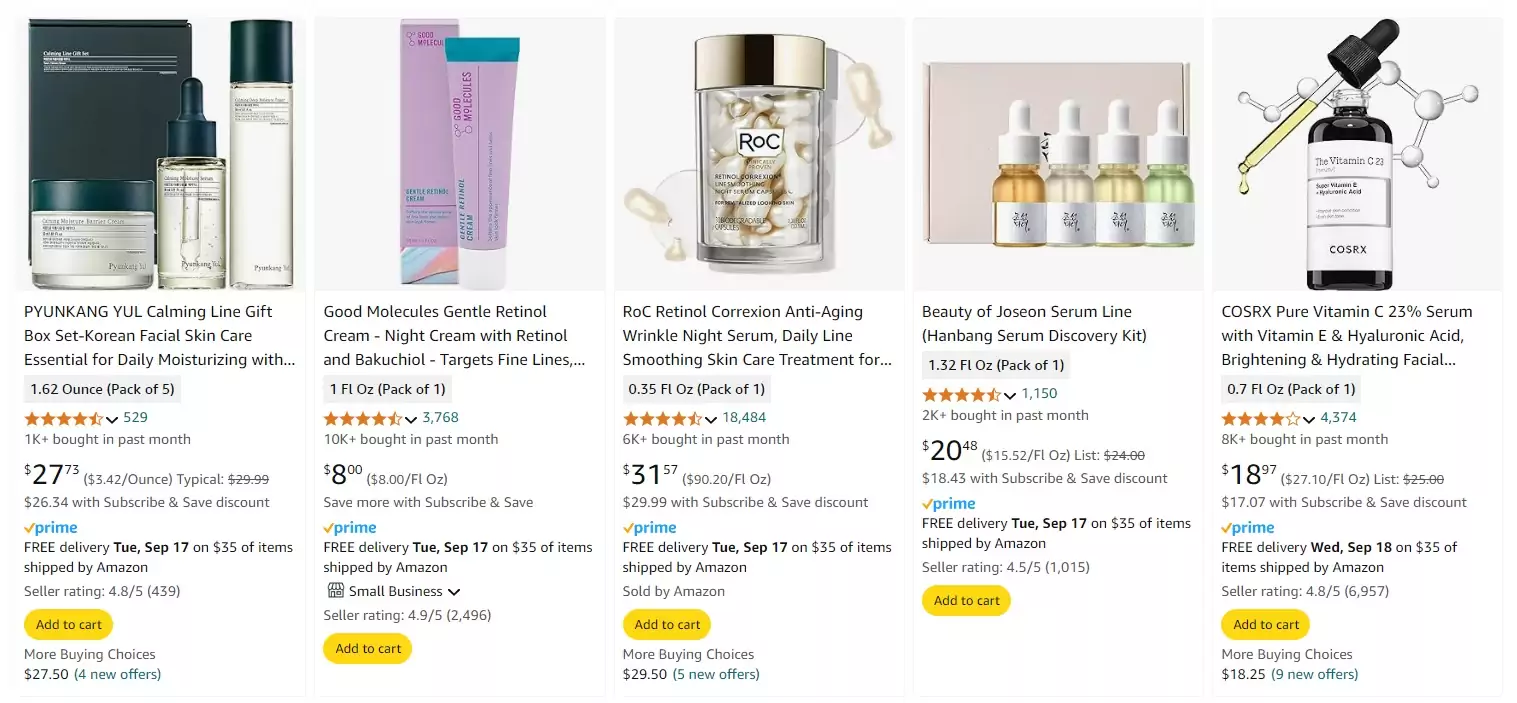
These platforms come with their own audience, so you don’t need to worry as much about attracting traffic to your site.
However, the downside is that your skincare product line will be listed alongside many competitors, and you’ll have less control over how your brand is presented.
There’s also a fee for using these platforms, which cuts into your margins. But for many, the built-in customer base is worth the trade-off.
🥊 One-off vs. subscription
When selling skincare, you also need to decide whether you’ll offer products as one-time purchases or as part of a subscription plan.
One-off sales are the most straightforward option—customers buy what they want when they want it. This allows new buyers to try your products without any long-term commitment.
However, people use skincare products regularly, which makes a subscription business model a natural fit.
You can offer customers the convenience of receiving their favorite products automatically at predetermined intervals, which—in turn—gives you more predictable revenue.
Price plays an important role in customer decisions—56% of people say affordability is the most important factor when choosing skincare products.
Subscriptions can help with this, as they often come with cost-saving perks.
For example, Vida Glow offers a 20% discount when customers choose to subscribe instead of making one-time purchases:

You could do the same by offering a small discount to subscribers, making it a win-win situation.
Here are two popular subscription options you could consider:
📬 Product subscription: Customers sign up to receive individual products, such as a face serum or moisturizer, at regular intervals. This option keeps things simple and ensures customers never run out of their favorite items.
📬 Box subscription: Alternatively, you can offer a curated box of routinely used products, so customers can benefit from a full skincare experience. This option adds an element of surprise and can be a great way to introduce new products to your loyal customers.
In choosing between one-off sales and subscriptions, think about your customers’ needs and what they most value.
🎯 Choose the right e-commerce platform
If you’re planning to sell directly to customers online, you’ll need to find the right e-commerce platform to set up your shop.
Here’s what to look for:
✅ Easy to customize: Choose a platform that’s user-friendly and doesn’t require any coding skills or complex plugins, so you can focus on your business, not tech issues.
✅ High-quality website: Your site should be SEO-friendly and look great on all devices, from desktops to mobiles and tablets.
✅ Trustworthy payments: Look for a platform that includes reliable, built-in payment options so customers can check out with ease and confidence.
✅ Stay tax-compliant: Each region has different tax rules. Make sure your platform automatically calculates and includes the applicable taxes for every purchase.
✅ Extensive reporting: A good platform should provide you with insights like customer behavior, churn rate, and page views.
If you want to offer subscription-based options, Subbly is an excellent choice. It covers everything listed here and more, starting at just $29 per month.
Want to see whether it’s right for your skincare business? Try our free trial and explore the features firsthand.
4. Set your pricing
Choosing the right price for your skincare line involves two key steps: first, calculating the cost to create and potentially ship your products, and second, comparing your price with competitors.
Let’s say you’re developing a subscription skincare line for teenagers. Each box will help them establish a healthy skincare routine with regular deliveries.
When calculating your costs, break down each expense:
🤑 Ingredients: Depending on what’s inside, this can range from $2 to $5 per product. Let’s assume three products per box, totaling around $10.
🤑 Packaging: On average, the cost per container might be $1.50, and the shipping box itself could cost around $2. In total, packaging costs could be $6.
🤑 Labor: Whether you’re manufacturing the products yourself or working with a small manufacturer, labor costs might come to $3 per box.
🤑 Shipping: Depending on the size and weight of your box, domestic shipping could range from $5 to $10 per box. Let’s say you cut a good deal with your carrier, so it’s $5 per box.
On top of this, you should also consider costs like digital marketing, website maintenance, and payment processing fees, which might add up to $2 per box.
To price your box profitably, you’ll need to set it higher than $26. For instance, pricing each box at $30 to $35 would give you a profit margin of around $9 to $14 per box.
Next, compare your price with competitors. If similar subscription boxes for teenagers are priced at $40, you could offer yours at $35 to stay competitive.
Want to learn more about pricing strategies? Read our latest article to get all the details.
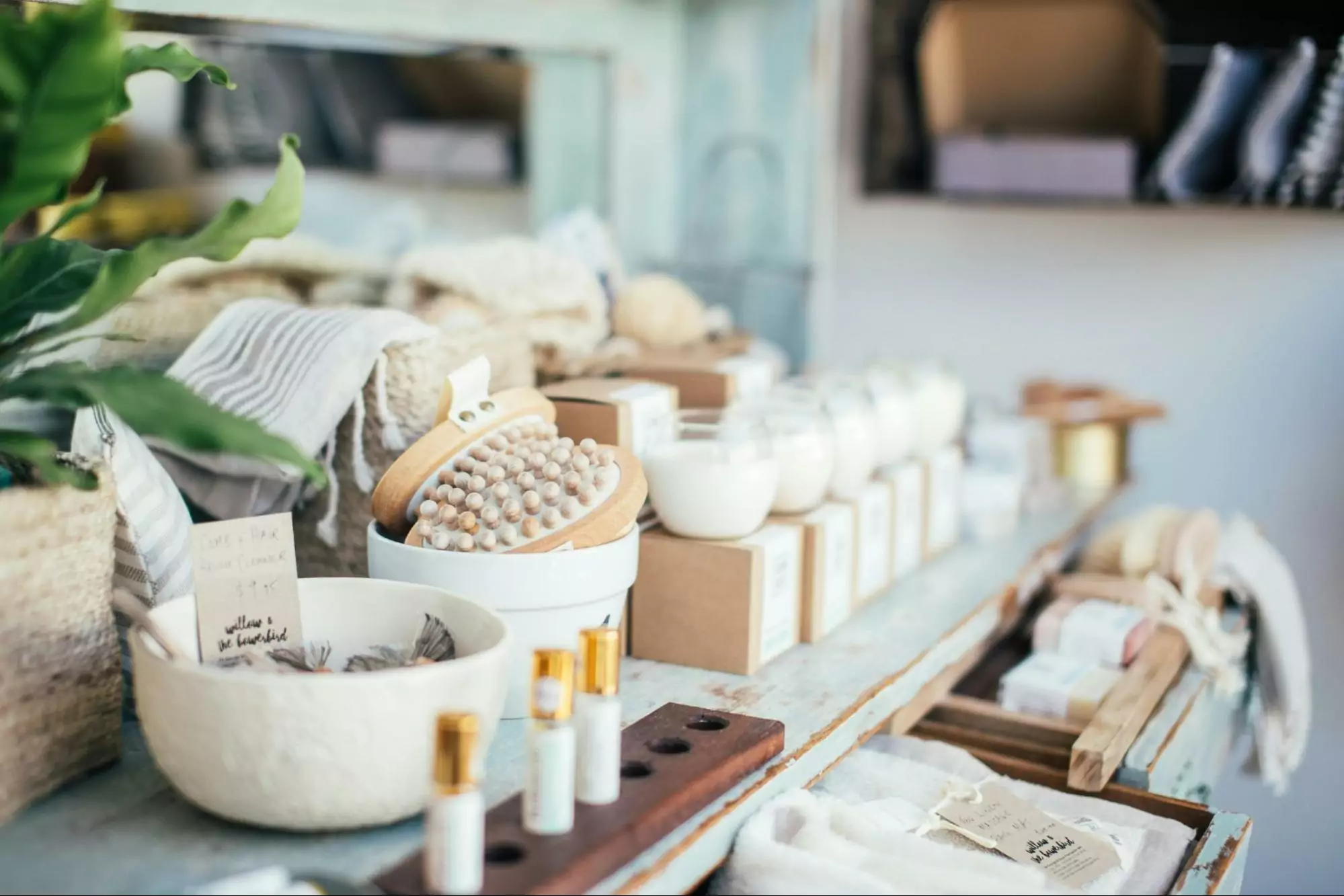
5. Plan your order fulfillment
To run a successful skincare line, having a solid order fulfillment plan is key.
If your products aren’t moving, you’re not making a profit, and some products, like those with natural ingredients, can spoil over time.
However, it’s important not to overestimate demand at the start. For instance, producing 5,000 units before selling your first item could leave you with excess stock.
It’s smarter to gauge interest in your products before scaling up your fulfillment process.
💡 Pro tip: Start small with a pre-launch
Start small by ordering a manageable batch of products—50 or 100 units, for example—and immediately launch your marketing efforts (see next section).
This quick test will show you how well your product resonates with your target market.
Not only will this validate your business idea, but it will also provide insights into setting up an effective fulfillment strategy.
Skipping this step could mean spending valuable time on an idea without market appeal, leaving you with unsold inventory that may expire.
Once you’ve confirmed a strong interest in your skincare line, it’s time to implement a fulfillment plan that can keep up with growing demand.
Here are some best practices to consider at this stage:
🚚 Work with a 3PL company
A third-party logistics (3PL) company handles storage, packing, and shipping for you. This means you don’t have to manage a warehouse or shipping on your own.
It’s a great option if you’re focused on growing your skin care business and want to outsource the logistics side. Plus, they often offer better shipping rates due to their volume of shipments.
🚚 Follow the FIFO inventory method
First in, first out (FIFO) means that the oldest products in your inventory get shipped out first. This is especially important for skincare, where ingredients may have expiration dates.
By using FIFO, you reduce the risk of products expiring before they’re sold, ensuring your customers always get fresh, high-quality products.
🚚 Utilize kitting and assembly services
If your skincare line includes bundled products—such as a subscription box including a cleanser, toner, and moisturizer—kitting and assembly services can help.
These services package multiple products into a single kit, streamlining the process and making it easier for you to manage.
Market Your Business
The final step to growing your skincare line is connecting with the customers who need it. Marketing is key, and here’s how you can go about it:
🌟 Create a successful skincare brand
When people are drawn to skincare products, it’s often because of the brand.
Maybe it’s the natural, earthy colors that make a product feel eco-friendly, or a bold, catchy brand name that promises to solve all their skin concerns.
Branding is essential because it helps you stand out. Without it, your line could be overlooked.
To create your own skincare brand, focus on choosing a name and color scheme that reflects the goals of your product.
For example, if you target teens with a fun, youthful vibe, use bright, playful colors. If you aim for luxury skincare, opt for elegant, muted tones that suggest sophistication.
🚀 Launch your website
Once you’ve established your brand, it’s time to launch your website. Choose a platform with customizable templates, so your site can reflect your brand’s unique look and feel.
For example, platforms like Subbly offer a beauty-specific template that you can tweak with your own photos and colors.
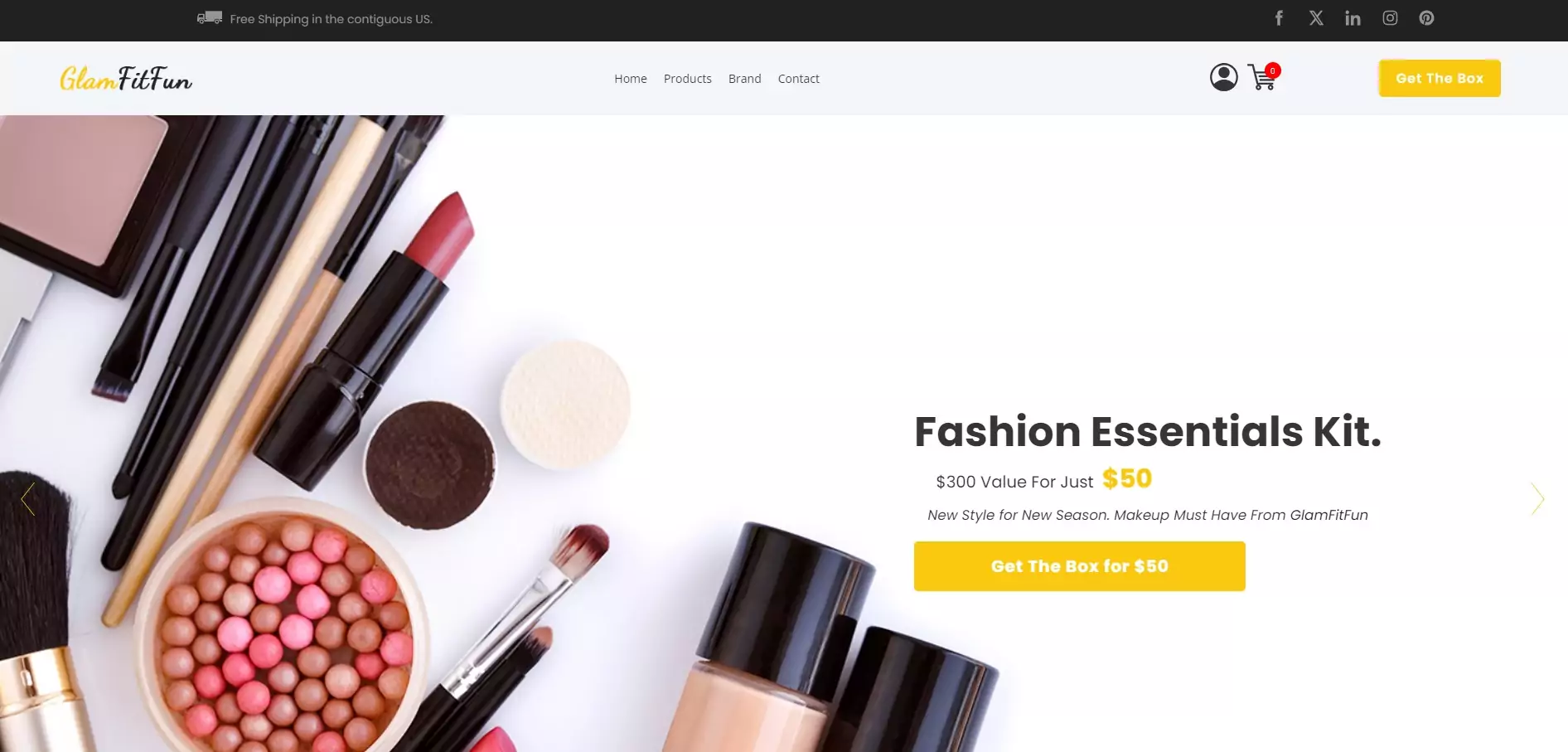
This makes it easy to create a professional, eye-catching website without needing a lot of technical skills.
📣 Get the word out
With your website up and running, it’s time to start driving traffic to it.
Marketing takes effort, so if it’s within your budget, you might consider hiring a professional. But if you’re just starting out, here are a few steps you can take yourself:
- Platforms like Instagram and TikTok are perfect for a skincare brand. You can post short videos, before-and-after results, and collaborate with beauty influencers who can promote your products among their followers.
- Set up Google Ads or Facebook Ads to boost your visibility. With pay-per-click, your products can appear at the top of search results or on banners while potential customers browse online.
On top of this, here are some extra ideas to help get more customers on board:
💥 Offer virtual consultations: Set up online skincare consultations where you can recommend products to customers directly, creating a personal connection.
💥 Host skincare workshops: Host virtual or in-person workshops that teach potential customers how to use your products or develop a skincare routine.
💥 Set up a referral program: Reward existing customers with discounts or freebies when they refer a friend, helping you grow your customer base through word-of-mouth.
By following these steps, you can build a strong presence and, who knows, your skincare line could be the next big thing in the beauty industry.
How to Start a Skincare Line with Subbly
Starting a skincare line takes dedication and hard work, and with so much effort going into it, you want to make sure your business is set up for success.
Choosing an online, direct-to-consumer subscription business model is an ideal match for a skincare line aiming to become the next big thing.
Unlike other e-commerce platforms, Subbly gives you all the tools you need to launch and grow your skincare business.
Your customers can easily subscribe to their favorite products, ensuring you have steady, recurring revenue so you can focus on scaling your brand.
Our customizable bundles are ideal for skincare businesses. You can bundle your products just like the fictional Roastora Club bundles theirs—test this checkout flow now.
Ready to take the next step? Explore the features Subbly offers and start a free trial to see how it can help your skincare line thrive.

